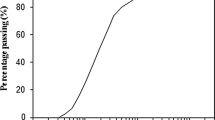Abstract.
Nano- SiO2 and microsilica are two types of additives with the same elemental structure but different particle sizes that are introduced by the researchers for ground improvement. The major difference in the two additive materials is the difference in the specific surface area, which its effect has been evaluated in this study. For this purpose through experimental tests, the effects of each of two additives on the change in geotechnical parameters of clay are compared. The additive percentages of each of the two additives are limited to 6% and the samples have been tested after a 28-day curing time. Variations in the consistency limits, compaction conditions of the samples, as well as undrained shear strength of soil have been measured for each mixture. The results of the unconfined compression test demonstrated that the nano- SiO2 had a more prominent effect in doses lower than 2% on the unconfined compressive strength and modulus of elasticity of the soil. By increasing the amount of nanomaterial, the strength of the samples is closer to that obtained for stabilized specimens with microsilica. In samples containing nanosilica, the increase in strength in percentages of less than 1% of the nano-material had a higher rate, while microsilica followed a relatively stable trend. By adding additives, the maximum dry density dropped up to 5% and shown a higher optimum moisture content. The plasticity changes were somewhat different for both additives. By adding more than 2% of nano- SiO2 , an increase in the liquid limit and the plasticity index of soil were observed, while microsilica slightly reduced these parameters. The X-Ray Diffraction (XRD) showed that no significant chemical reaction was occurred in the soil by additives. Moreover, the examination of Field Emission Scanning Electron Microscopy (FESEM) demonstrated that both materials played a significant role in reducing porosity and creating particle integrity. However, the pattern of filling the pores and enclosing particles by the two materials were different. This difference was particularly influential in terms of water absorption by the sample.
Similar content being viewed by others
References
Q. Li, J. Chen, Q. Shi, S. Zhao, Adv. Mater. Sci. Eng. 2014, 1 (2014)
E. Kalkan, S.J.E.G. Akbulut, Eng. Geol. 73, 145 (2004)
K. Badv, H. Emdadi, Sharif Civ. Eng. 32, 91 (2016) (in Persian)
Z.H. Majeed, M.R. Taha, J. Asian Sci. Res. 2, 587 (2012)
E. Nohani, E. Alimakan, Int. J. Life Sci. 9, 25 (2015)
L. Gao, K. Ren, Z. Ren, X. Yu, Soil Mech. Found. Eng. 52, 218 (2018)
L. Gao, K. Ren, Z. Ren, X. Yu, Mar. Georesour. Geotechnol. 36, 465 (2018)
N. Ghasabkolaei, A.J. Choobbasti, N. Roshan, S.E. Ghasemi, Arch. Civ. Mech. Eng. 17, 639 (2017)
G. Zhang, Soil nanoparticles and their influence on engineering properties of soils, in Advances in Measurement and Modeling of Soil Behavior (ASCE, 2007)
Y. Qing, Z. Zenan, K. Deyu, C. Rongshen, Construct. Build. Mater. 21, 539 (2007)
S.H. Bahmani, B.B.K. Huat, A. Asadi, N. Farzadnia, Construct. Build. Mater. 64, 350 (2014)
N. Ghasabkolaei, A. Janalizadeh, M. Jahanshahi, N. Roshan, S.E. Ghasemi, Eur. Phys. J. Plus 131, 134 (2016)
S. García, P. Trejo, O. Ramírez, J. López-Molina, N. Hernández, Influence of nanosilica on compressive strength of lacustrine soft clays, in Proceedings of the 19th International Conference on Soil Mechanics and Geotechnical Engineering, Seoul, Korea (2017)
F. Changizi, A. Haddad, Proc. Inst. Civ. Eng. 170, 62 (2017)
ASTM D2487, Standard Practice for Classification of Soils for Engineering Purposes (Unified Soil Classification System) (ASTM International, West Conshohocken, 2017)
ASTM D4318, Standard Test Methods for Liquid Limit, Plastic Limit, and Plasticity Index of Soils (ASTM International, West Conshohocken, 2005)
ASTM D698, Standard Test Methods for Laboratory Compaction Characteristics of Soil Using Standard Effort (ASTM International, West Conshohocken, 2000)
ASTM D2166/D2166M, Standard Test Method for Unconfined Compressive Strength of Cohesive Soil (ASTM International, West Conshohocken, 2013)
J.I. Goldstein, D.E. Newbury, D.C. Joy, C.E. Lyman, P. Echlin, E. Lifshin, L. Sawyer, J. Michael, Scanning Electron Microscopy and X-Ray Microanalysis, 4th ed. (Springer, New York, 2018)
Author information
Authors and Affiliations
Corresponding author
Additional information
Publisher’s Note
The EPJ Publishers remain neutral with regard to jurisdictional claims in published maps and institutional affiliations.
Rights and permissions
About this article
Cite this article
Ahmadi, H., Shafiee, O. Experimental comparative study on the performance of nano-SiO2 and microsilica in stabilization of clay. Eur. Phys. J. Plus 134, 459 (2019). https://doi.org/10.1140/epjp/i2019-12918-1
Received:
Accepted:
Published:
DOI: https://doi.org/10.1140/epjp/i2019-12918-1




